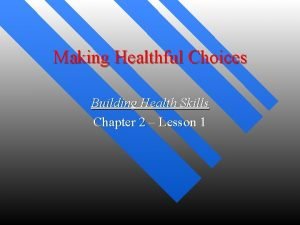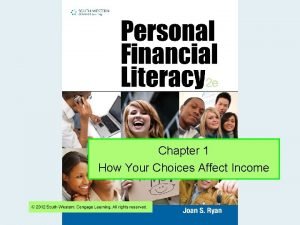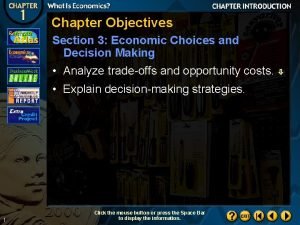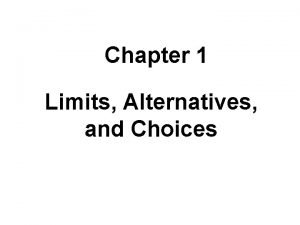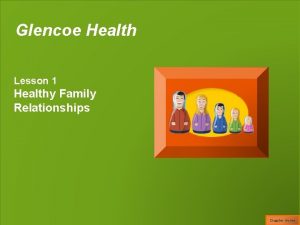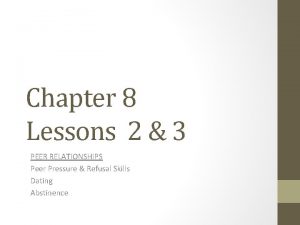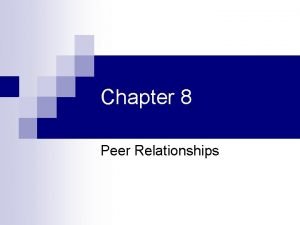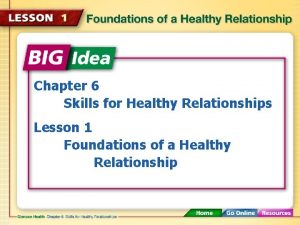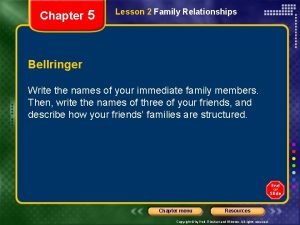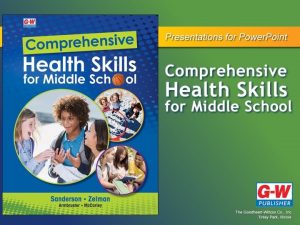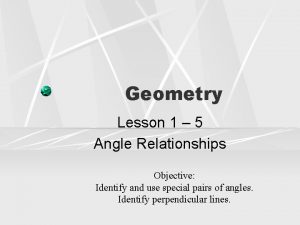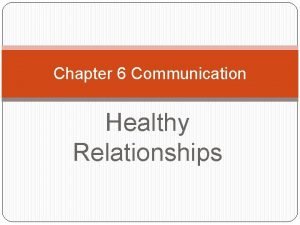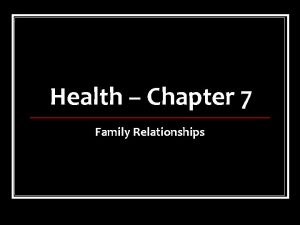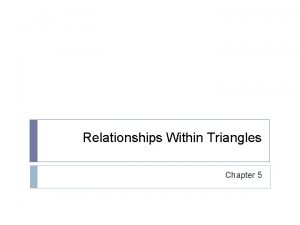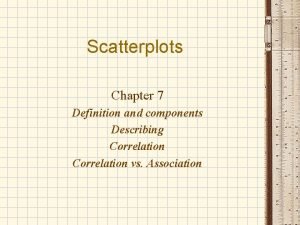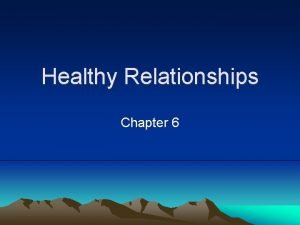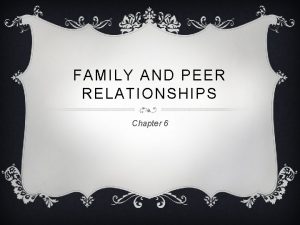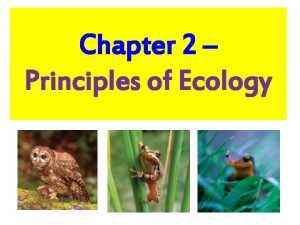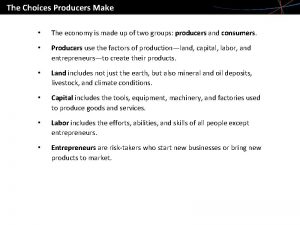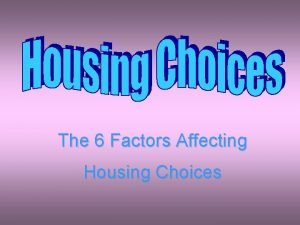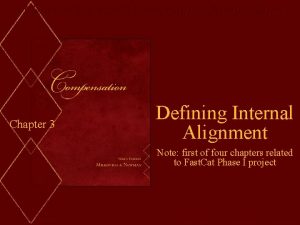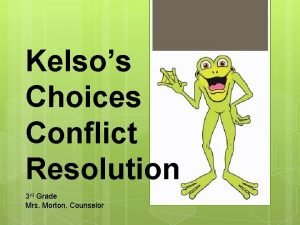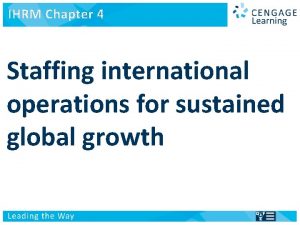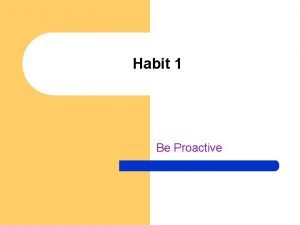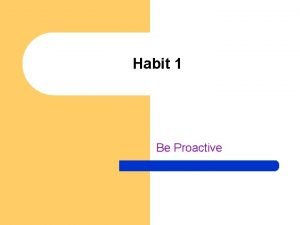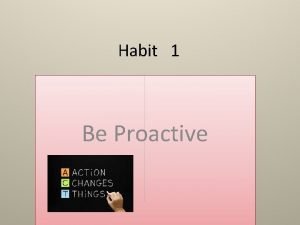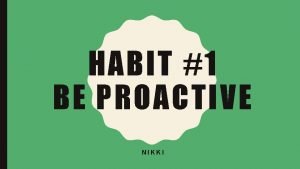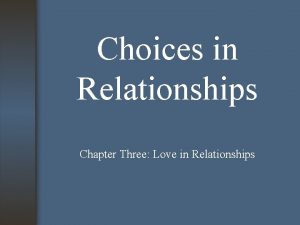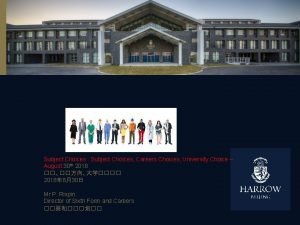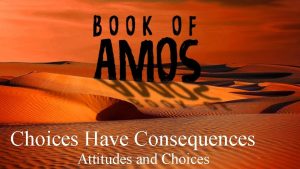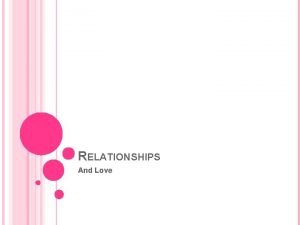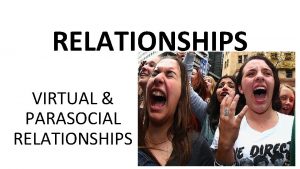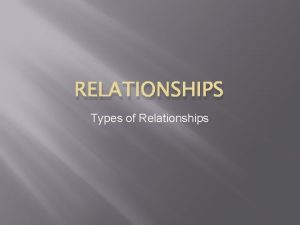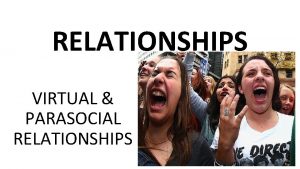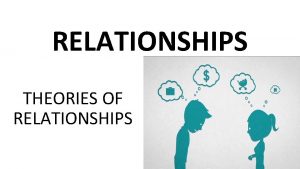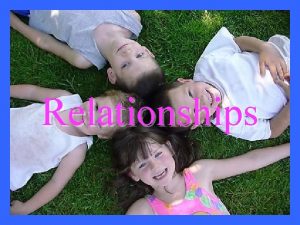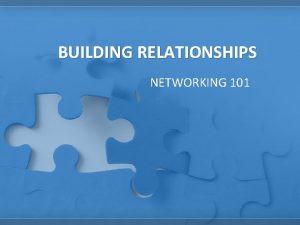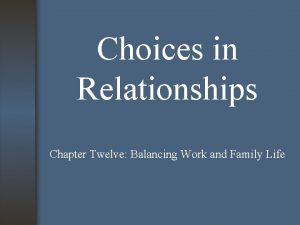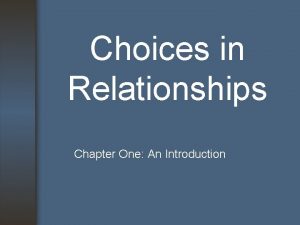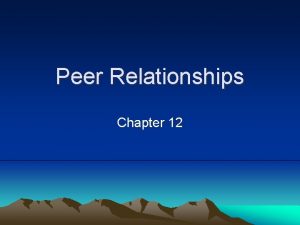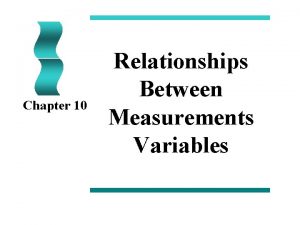CHAPTER 1 Choices in Relationships Chapter 1 Choices









































- Slides: 41

CHAPTER 1 Choices in Relationships

Chapter 1: Choices in Relationships Introduction Quote: It’s choice – not chance – that determines your destiny. Jean Nidetch, Founder of Weight Watchers Discussion: What is the purpose of family? How many different types of families currently exist in our society today? What are their differences and similarities?

Chapter 1: Choices in Relationships Chapter Outline Marriage Family Differences between Marriage and Family Choices in Relationships – View of the Text Theoretical Frameworks for Viewing Marriage and the Family Research Process and Caveats The Future of Marriage Summary

Chapter 1: Choices in Relationships Introduction Food for thought. . . In a nationwide study 78% of 201, 818 undergraduate students at 279 colleges and universities identified “raising a family” as an essential life objective. In another study of 2, 922 undergraduate students, 50% identified “happy marriage” as a top life value…even above “having a career that I love” (28%).

Marriage: Elements of Marriage Traditional Marriage Legal Contract Emotional Relationship Sexual Monogamy Legal Responsibility for Children Announcement /Ceremony

Marriage: Elements of Marriage Food for thought… Over 95% of U. S. adults (women - 96% and men 95. 6%) aged 75 and older report having been married at least once. With regard to reasons to get married, adults point to love (93%), making a lifelong commitment (87%) and companionship (81%) rather than having children (59%) or financial stability. 80% percent of first marriages occur in a religious context. The ceremony is a joyous occasion attended by friends, family, and well wishers. No one attends an individual’s divorce.

Marriage: Benefits of Marriage Health Longevity Spouses have fewer hospital admissions, see a physician more regularly, and are sick less often. Spouses live longer. Happiness Spouses report being happier. Sexual Spouses report being more satisfied satisfaction with their sex lives.

Marriage: Benefits of Marriage Money Spouses have more economic resources. Lower expenses Two can live more cheaply together than separately. Drug use Spouses have lower rates of drug use and abuse. Connectedness Spouses are connected to more individuals.

Marriage: Benefits of Marriage Children History Crime Rates of high school dropouts, teen pregnancies, and poverty are lower. Spouses develop a shared history across time. Spouses are less likely to be involved in crime. Loneliness Spouses are less likely to report loneliness.

Marriage: Types of Marriage Polygamy: type of marriage involving more than two spouses. Polygyny: type of marriage involving one husband two or more wives. Polyandry: type of marriage in which one wife has two or more husbands. Pantagamy: a group marriage in which each member of the group is “married” to the others.

Family: Definitions of Family Challenges to the Definition U. S. Census Definition Sociological Definition Civil Unions Domestic Partnerships What is your definition of family?

Family: Definitions of Family Food for thought… 86% percent of U. S adults say a single parent and child constitute a family; nearly as many (80%) say an unmarried couple living together with a child is a family. 63% percent say a gay or lesbian couple raising a child is a family. New Hampshire, Massachusetts, Connecticut, Vermont, and Iowa recognize marriages between same-sex individuals. Short of marriage; New Jersey recognizes committed gay relationships as civil unions. Some individuals view their pets as part of their family. In a Harris Poll (2007) survey of 2, 455 adults, 88% regarded their pets as family members—more women (93%) than men (84%), and more dog owners (93%) than cat owners (89%).

Family: Types of Families Family of Origin Family of Procreation Nuclear Family Traditional, Modern, and Postmodern Family Binuclear Family Blended Family Extended Family

Differences Between Marriage and Family: Changes in Marriage and the Family in the Last Sixty Years

Differences Between Marriage and Family: Changes in Marriage and the Family in the Last Sixty Years 1950 2012 Family Relationship Values Individuals who wanted to remain single or childless were considered deviant. Individuals who remain single or childfree experience social understanding and sometimes encouragement. Gender Roles Rigid gender roles Egalitarian gender roles Sexual Values Marriage was regarded as the only appropriate context for intercourse. Concerns about safer sex have taken precedence over the marital context for sex.

Differences Between Marriage and Family: Changes in Marriage and the Family in the Last Sixty Years 1950 2012 Homogamous Mating Strong social pressure existed to date and marry within one’s own racial, ethnic, religious, and social class groups. Dating and mating have become more heterogamous, with more freedom to select a partner socially different than oneself. Cultural Silence on Intimate Relationships Intimate relationships were not an appropriate subject for the media. Mass media is open about sexuality and relationships behind closed doors. Divorce Society strongly disapproved of divorce. Divorce has replaced death as the endpoint of a majority of marriages.

Differences Between Marriage and Family: Changes in Marriage and the Family in the Last Sixty Years 1950 2012 Familism vs. Individualism Families were focused on the needs of the children. Adult agenda of work and recreation have taken on an increased importance with less attention given to children. Homosexuality Same-sex emotional and sexual relationships were a culturally hidden phenomena. Gay relationships are increasingly a culturally open phenomena. Scientific Scrutiny Aside from Kinsey, few studies were conducted on intimate relationships. Acceptance of scientific study of marriage and intimate relationships. Family Housing Husbands and wives lived Husbands and wives may in the same house. “live apart together” (LAT).

Choices in Relationships: When do two people define themselves as a couple? Chaney and Marsh (2009) interviewed 62 married and 60 cohabiting couples to find out when they first identified themselves as a couple. There were four “markers”: Relationship Events Affection/Sex Children Time/Money When did you/will you have “the talk? ”

Choices in Relationships: Facts about Choices in Relationships Not To Decide Is To Decide Not making a decision is a decision by default. Ex. : Not deciding to use birth control is deciding to have a child & staying in a “bad” relationship. Your examples? Some Choices Require Corrections Once a choice is having consistent negative consequences, it is important to make new choices, and move forward. Your examples?

Choices in Relationships: Facts about Choices in Relationships Choices Involve Trade-offs Every relationship choice you make will have a downside and an upside. Choices Include Selecting a Positive or Negative View In spite of an unfortunate event in your life, you can choose to see the bright side. Marriage vs. Freedom and Control Breaking up. Others? Choices Involve Different Decision-making Styles “I am in control” (45%) “I am experimenting and learning” (33%) “I am struggling but growing” (14%) “I have been irresponsible” (3%)

Choices in Relationships: Facts about Choices in Relationships Choices Produce Ambivalence Choosing among options and trade-offs often creates conflicting feelings as to what course of action to take. “Can’t live with them, can’t live without them” Anxiety is normative Most Choices Are Revocable; Some Are Not Most choices can be changed. Sexual activity STD’s Other examples?

Choices in Relationships: Facts about Choices in Relationships Choices of “Generation Y” (or the Millennials) Culturally different from their parents Typically more relaxed about relationship choices Choices are Influenced by the Family Life Cycle Before marriage, individualism characterizes most thinking and decisions. Making Wise Choices Is Facilitated by Learning Decision -Making Skills Steps in decision-making include evaluating the issues involved, identifying courses of action, weighing the consequences, and being attentive to your motivations.

In-class Activity On a piece of paper, quickly detail: Your “best” relationship choice(s) and the outcome Your “worst” relationship choice(s) and the outcome Now, on your piece of paper, quickly detail: Your most difficult relationship choice(s) and the outcome Pay attention to the range of difficult relationship choices experienced by class members

Choices in Relationships: Global, Structural/Cultural, and Media Influences on Choices Globalization “…globalization is the critical driving force that is fundamentally restricting the social order around the world, and families are at the center of this change. ” Economic, political, and religious events around the world affect marriages and families. Institutions The largest elements of society are social institutions. These include: Family Economy Education Religion

Choices in Relationships: Global, Structural/Cultural, and Media Influences on Choices Social Groups Definition: Two or more people who have a common identity, interact, and form a social relationship. Social groups may be categorized as primary or secondary. Primary groups are characterized by interaction that is intimate and informal. Secondary groups are characterized by interaction that is impersonal and formal.

Choices in Relationships: Global, Structural/Cultural, and Media Influences on Choices Statuses The status(es) we occupy largely define our social identity. The statuses in a family may consist of mother, father, child, sibling, stepparent, and so on. Roles Every status is associated with many roles, or sets of rights, obligations, and expectations associated with a status. Social statuses identify who we are; roles identify what we are expected to do. Roles guide our behavior and allow us to predict the behavior of others. What are your statuses and the roles associated with them?

Choices in Relationships: Global, Structural/Cultural, and Media Influences on Choices Culture Two central elements of culture are beliefs and values. Beliefs refer to definitions and explanations about what is true. Values are standards regarding what is good and bad, right and wrong, desirable and undesirable. Media TV Internet Movies Print

Choices in Relationships: Other Influences on Relationship Choices Family of Origin Habits Personality Friends, Relationships, and Life Experience What are these factors and how do they influence your choices on a daily basis?

Theoretical Frameworks for Viewing Marriage and the Family Theoretical Framework: a set of interrelated principles designed to explain a particular phenomenon. Social Exchange Framework Views interaction and choices in terms of cost and profit. Family Life Course Development Framework Emphasizes the important role of transitions of individuals that occur in different periods of life and in different social contexts.

Theoretical Frameworks for Viewing Marriage and the Family Structural-Functional Framework Emphasizes how marriage and family contribute to society First, families serve to replenish society with socialized members. Second, marriage and the family promote the emotional stability of the respective spouses. Third, families provide economic support for their members.

Theoretical Frameworks for Viewing Marriage and the Family Structure-Function Framework (Con’t. ) Additional Physical functions may include: Care Regulation of Sexual Behavior Status Placement Social Control

Theoretical Frameworks for Viewing Marriage and the Family Conflict Framework The view that individuals in relationships compete for valuable resources. Symbolic Interaction Framework Views marriages and families as symbolic worlds in which the various members give meaning to each other’s behavior. Definition of the Situation Looking-Glass Self-Fulfilling Prophecy

Theoretical Frameworks for Viewing Marriage and the Family Systems Framework Views each member of the family as part of a system and the family as a unit that develops norms of interaction. Feminist Framework Views marriage and family as contexts of inequality and oppression for women.

Research Process and Caveats: Steps in the Research Process: Identify the topic or focus of research Review the literature Develop hypotheses Decide on a method of data collection Get Institutional Review Board (IRB) approval Collect and analyze data Write up and publish results

Research Process and Caveats: Caveats to Consider in Research Quality Potential Research Problems in Marriage and Family

The Future of Marriage While marriage is a lifestyle choice, it is declining somewhat among all groups in the U. S. However, even with the decline, there is no evidence that marriage will cease to be a life goal. Six in ten “never-married” adults say they want to get married at some point.

Quick Quiz Which of the following is NOT considered one of the elements of marriage? 1. a. b. c. d. Legal Contract Emotional Relationship Maintenance of Separate Households Legal Responsibility for Children

Quick Quiz Which of the following is a generic term for marriage involving more than two spouses? 2. a. b. c. d. Polygamy Monogamy Homogamy Endogamy

Quick Quiz According to the text, what is a problem with the U. S. Census’s definition of family? 3. a. b. c. d. It does not mention blood relation between the couple. It mentions love as a prerequisite for marriage. It does not include foster families or long-term couples (heterosexual or homosexual) that live together. It is entirely too scientific.

Quick Quiz The family into which you were born or the family in which you were reared is referred to as your: 4. a. b. c. d. family of procreation family of orientation family of origin nuclear family

Quick Quiz Which of the following is considered a major change regarding marriage and families between 1950 and 2012? 5. a. b. c. d. Egalitarian gender roles have become more common. Dating and mating have become more heterogamous. Sexuality and relationships are more visible due to the media. All of the above.
 Family of orientation
Family of orientation Lesson 2 making responsible decisions and setting goals
Lesson 2 making responsible decisions and setting goals Lesson 2 our economic choices
Lesson 2 our economic choices Chapter 9 making healthy food choices
Chapter 9 making healthy food choices Explain how job choices affect income.
Explain how job choices affect income. Chapter 1 section 3 economic choices and decision making
Chapter 1 section 3 economic choices and decision making Chapter 1 limits alternatives and choices
Chapter 1 limits alternatives and choices Chapter 7 family relationships
Chapter 7 family relationships Chapter 8 lesson 1 safe and healthy friendships
Chapter 8 lesson 1 safe and healthy friendships Chapter 7 family relationships
Chapter 7 family relationships Principles of ecology chapter 2
Principles of ecology chapter 2 Chapter 2 section 1 organisms and their relationships
Chapter 2 section 1 organisms and their relationships Chapter 2 principles of ecology
Chapter 2 principles of ecology Chapter 2 principles of ecology answer key
Chapter 2 principles of ecology answer key Chapter 8 lesson 1 safe and healthy friendships
Chapter 8 lesson 1 safe and healthy friendships Chapter 6 skills for healthy relationships lesson 1
Chapter 6 skills for healthy relationships lesson 1 Chapter 5 family relationships answers
Chapter 5 family relationships answers Priorities in a healthy relationship
Priorities in a healthy relationship Relationships within triangles
Relationships within triangles Vertical angles theorem
Vertical angles theorem Strong relationships
Strong relationships Jokes about communication
Jokes about communication Three r's for stopping domestic violence
Three r's for stopping domestic violence Chapter 5 relationships within triangles
Chapter 5 relationships within triangles Describing scatterplots
Describing scatterplots Chapter 6 skills for healthy relationships
Chapter 6 skills for healthy relationships Chapter 6 building healthy peer relationships
Chapter 6 building healthy peer relationships Chapter 2 section 1 organisms and their relationships
Chapter 2 section 1 organisms and their relationships Read the text below match choices a h to 1 5
Read the text below match choices a h to 1 5 Choices producers make
Choices producers make Factors that affect housing choices
Factors that affect housing choices Rhetorical devices examples
Rhetorical devices examples Rhetorical
Rhetorical Strategic choices in internal alignment design
Strategic choices in internal alignment design Kelso conflict resolution
Kelso conflict resolution Characteristics of ihrm
Characteristics of ihrm Examples of reactive language
Examples of reactive language Proactive language vs reactive language
Proactive language vs reactive language Habit 1 be proactive examples
Habit 1 be proactive examples Reactive language vs proactive language
Reactive language vs proactive language Space cat choices
Space cat choices Space cat exigence
Space cat exigence

